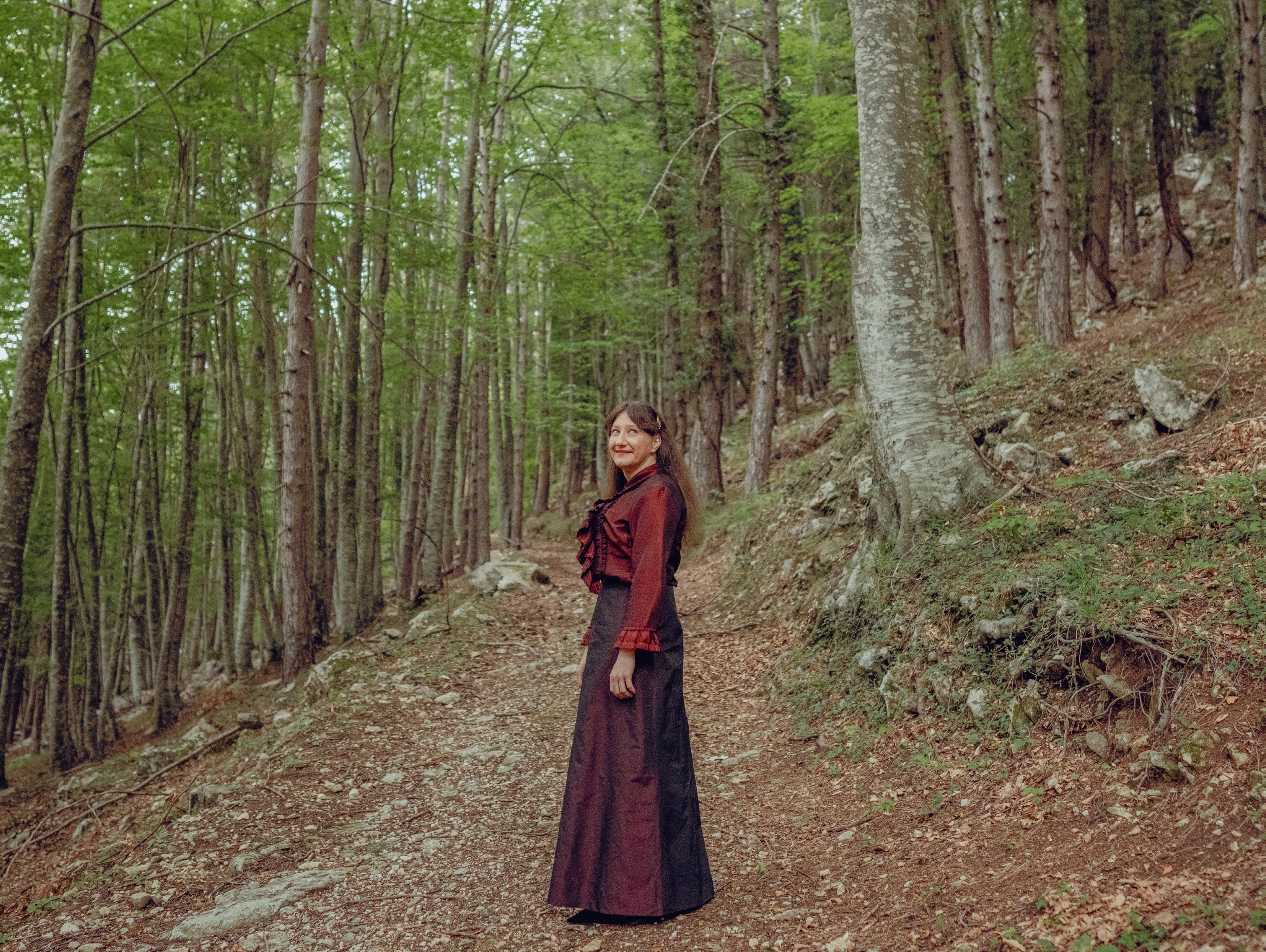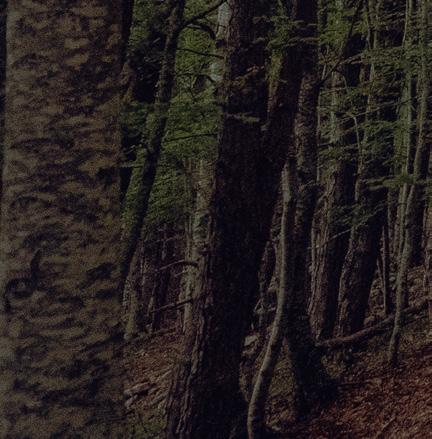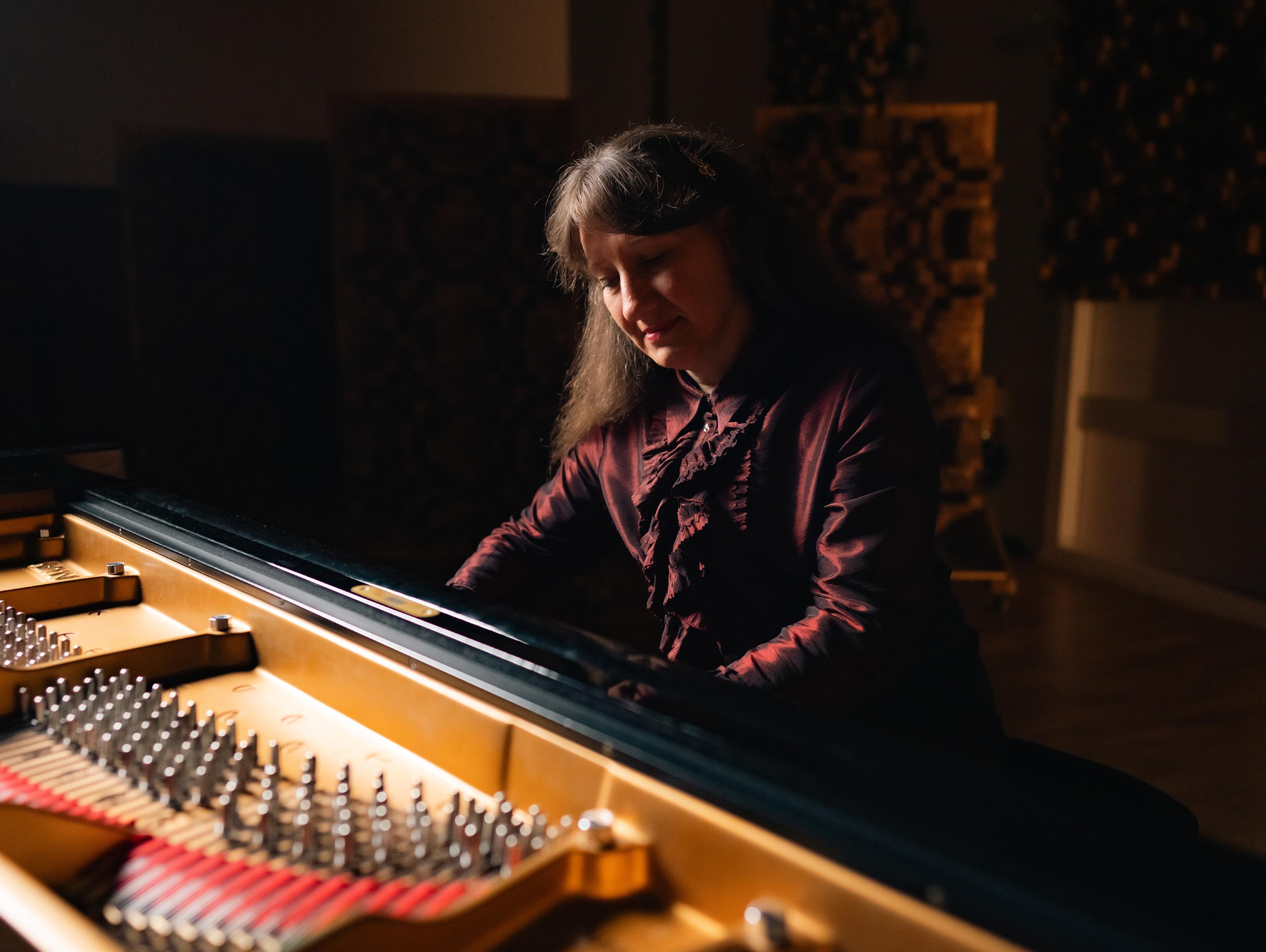

MOMENTS
OLGA GEORGIEVSKAYA PIANO

SERGEI RACHMANINOV (1873-1943)
6 MOMENTS MUSICAUX, OP. 16 (1896)







1. NO. 1 IN B-FLAT MINOR. ANDANTINO 07’21
2. NO. 2 IN E-FLAT MINOR. ALLEGRETTO 03’40
3. NO. 3 IN B MINOR. ANDANTE CANTABILE 05’59
4. NO. 4 IN E MINOR. PRESTO 03’13



5. NO. 5 IN D-FLAT MAJOR. ADAGIO SOSTENUTO 04’11
6. NO. 6 IN C MAJOR. MAESTOSO 05’00





ALEXANDER DARGOMYZHSKY (1813-1869) / OLGA GEORGIEVSKAYA
FROM SONGS AND ROMANCES
7. ‘THE YOUTH AND THE MAIDEN’ 01’23


OLGA GEORGIEVSKAYA


8. ‘I AM SAD’ 02’02



FRANZ LISZT (1811-1886)
FROM ANNÉES DE PÈLERINAGE, PREMIÈRE ANNÉE: SUISSE, S.160 (1848/55)



9. CHACONNE ON THEMES OF PURCELL (2020) 08’20
10. NO. 6: VALLÉE D’OBERMANN 13’03





FROM ANNÉES DE PÈLERINAGE, DEUXIÈME ANNÉE: ITALIE, S.161 (1848/55)
FANTASIA QUASI SONATA
OLGA GEORGIEVSKAYA PIANO



11. NO. 7: APRÈS UNE LECTURE DU DANTE. 16’13
TOTAL PLAY TIME: 70’30




























Each work in this programme is unique and in its own way represents an unusual style in the art of the piano. The programme opens with Sergei Rachmaninov’s Moments Musicaux, a cycle by one of my most beloved composers. These brief yet evocative pieces capture a range of experiences: they unfold before the listener as a vivid, picturesque soundscape, enchant with their eloquence and expressiveness, invite us to a calm philosophical reflection, or thrill the listener with their grandeur. Each of the six pieces vividly reflects Rachmaninov’s characteristic imagination, together forming a cohesive world governed by the cycle’s internal dramaturgy.



The genre of piano transcription, in my view, offers a fascinating realm for musical creativity. It is a reinterpretation of original material, reflected by a new musical text based on the source. Alexander Dargomyzhsky’s two songs – ‘The Youth and the Maiden’ and ‘I Am Sad’ – are set to the words of renowned Russian poets Alexander Pushkin and Mikhail Lermontov. In the first song, the composer crafts a delicate and striking miniature, while the second, despite its apparent simplicity, reveals the profound emotional intensity of the Romantic hero. My Chaconne on Themes of Purcell is based on the famous ‘Dido’s Lament’ from Purcell’s Dido and Aeneas, one of the most impressive examples of the use of the ancient form of variations on basso ostinato.






The musical genius of Franz Liszt, akin to that of Sergei Rachmaninov, has profoundly influenced not only the art of composition but also the art of piano performance. Liszt’s unique integration of the performer’s and composer’s perspectives led to the creation of a variety of innovative and unique musical forms. Among these are ‘Vallée d’Obermann’ and ‘Après une Lecture du Dante: Fantasia quasi Sonata’, two of the most significant pieces from the first two volumes of his cycle Années de Pèlerinage. Compared to traditional variations, Liszt’s transformation of a single motif throughout these works showcases an astonishing range of possibilities, changing beyond recognition and evolving into diverse and contrasting imaginative worlds. Engaging with the boundless richness of the works of the great composers is an inexhaustible source of inspiration that I am eager to share with my listeners.























Sergei Rachmaninov and Franz Liszt were titans of the piano, both as performers and composers, using the instrument to create extraordinary, almost orchestral, textures. And both were adept at the art of transcription, a skill that Olga Georgievskaya demonstrates in three transcriptions of her own, which have never been committed to record until now.







Rachmaninov started piano lessons at the age of four and progressed swiftly. In 1889, aged 16, he was asked to prepare a piano duet transcription of Tchaikovsky’s ballet, The Sleeping Beauty, which proved a steep learning curve; the older composer was dissatisfied with the result, but later became a devotee of Rachmaninov’s music. Rachmaninov graduated from Moscow Conservatory in 1892, having already composed significant works including his Piano Concerto No. 1, but his productivity deteriorated after Tchaikovsky’s death, a decline compounded by the terrible reception of his Symphony No. 1 of 1895. Several years of depression and therapy followed, but Rachmaninov was offered his first conducting role at this time; this would soon become an integral part of his career, alongside piano performances and composing.











Rachmaninov’s Six moments musicaux were composed as bread-winning music in 1896, their title inspired by Schubert’s Six moments musicaux of 1828. In the first piece, the left hand’s lilting triplets undulate beneath a sinuous melody, growing in intensity, Rachmaninov blending elements of a nocturne with a theme and variations. A thrilling cadenza leads into a section of ascending right-hand sextuplets, before a return to the opening tempo and a further variation on the opening theme. The second piece is in the étude style, with virtuosic cascades of semiquavers and a central section characterised by sudden swells. In the third piece, Andante cantabile, the spacing of the piano writing has the sonorous quality of Russian choral music, transformed into a spikier texture of staccato octaves, before the funeral marchlike manner of the opening is brought out, the piece ending with solemn softness.













Resembling Chopin’s Revolutionary étude, the fourth piece features a fiendishly virtuosic left hand part of continuous sextuplets, punctuated by powerful gestures in the right hand. The fifth piece, Adagio sostenuto, is in complete contrast: a tranquil haven with left-hand triplets evoking a barcarolle – a piece emulating the gentle rocking of a boat. In the final Maestoso Rachmaninov creates a gloriously dense texture in which melodic lines are decorated by continuous demisemiquavers: a rich pianistic feast.


















Alexander Dargomyzhsky was a Russian composer who, following in the footsteps of his mentor Glinka, paved the way for the likes of Tchaikovsky and The Five (Borodin, Cui, Rimsky-Korsakov, Balakirev and Mussorgsky), particularly in the field of opera. His operas included Esmerelda after Victor Hugo, and, before Dvořák’s more famous telling of the same story, Rusalka. His songs were similarly skilful, reflecting his belief that the purpose of word setting is “to make musical sound directly express the word”. Dargomyzhsky’s lyrical, bittersweet song Yunosha i deva or ‘The youth and the maiden’ is a setting of a poem by Pushkin; a strange little vignette in which a woman reproaches a man – who promptly falls asleep on her shoulder, at which she holds him, smiling and weeping simultaneously. The song was published as No. 30 of Dargomyzhsky’s vast two-volume set of Songs and Romances. No. 36 of the same volume is Mne grustno (‘I am sad’), to a text by Lermontov in which the lover laments the prospect of their youthful beloved falling prey to gossip. Dargomyzhsky’s response to the poem is an autumnal piece through which a plaintive melody flows.








Olga Georgievskaya’s Chaconne on Themes of Purcell is based on the heartrending ‘Dido’s Lament’ from Henry Purcell’s opera Dido and Aeneas, composed in the 1680s. ‘Dido’s Lament’ unfolds over a recurring ‘ground bass’, which underpins her plea: ‘Remember me, but ah! forget my fate.’ Georgievskaya’s treatment of the material is a free elaboration with, in her words, ‘many more elements added to original texture, and some important transformations concerning musical form and structure as well. It’s something between transcription and composition, but based on Purcell’s original work.’






While Dargomyzhsky reflected his Russian heritage in his choice of poetry, Liszt reflected his nationality in various ways, incorporating gypsy music and Hungarian folksong into some works, and in others enshrining historical Hungarian figures. But he was also widely travelled, and the countries he visited are evoked in the three-volume collection of piano pieces, the Années de pèlerinage (Years of Pilgrimage), which trace the composer’s emotional (and physical) journey during key years of his life. The first volume is entitled ‘Première année: Suisse’ and was published in 1855, 20 years after Liszt spent time in the






























Swiss countryside with the (still married) Countess Marie d’Agoult, taking in pastures, mountain springs and storms. The sixth piece is called ‘Vallée d’Obermann’ (‘Obermann’s Valley’), a title borrowed from the epistolary novel of the same name by Étienne Pivert de Senancour (full name Étienne-Jean-BaptistePierre-Ignace Pivert de Senancour), set in Switzerland, in which a young man overwhelmed by nature and his thoughts concludes that only our feelings are true. On the score Liszt quoted both this work (“What do I want? Who am I? What do I ask of nature?”) and poetry by Byron on a similar theme. ‘Vallée d’Obermann’ was based on an earlier incarnation in Liszt’s Album de Voyageur and, late in Liszt’s life, was arranged for piano trio as Tristia, published in 1880.











Liszt’s ‘Après une Lecture du Dante: Fantasia quasi Sonata’ or ‘Dante Sonata’ also underwent numerous incarnations, and appeared in the second volume of Liszt’s Années de pèlerinage, ‘Deuxième année: Italie’, published in 1858. The work was inspired by Victor Hugo’s 1836 poem Après une lecture de Dante, and began life as a small-scale piece called Fragment after Dante composed towards the end of the 1830s. Liszt returned to the piece in Weimar in 1849, developing it into a vividly characterised single-movement sonata that pits devilish chromaticism – including the tritone, long held to be the ‘devil’s interval’ – against a heavenly chorale. The piece ends with a flurry of dramatic textures, a thrilling conclusion that is nevertheless slightly ambiguous; we are left feeling a little unsure as to who has triumphed…

















Joanna Wyld














Award-winning Russian pianist Olga Georgievskaya has performed as a recitalist and soloist with major orchestras across Russia, including in Moscow, Murmansk, Belgorod, Krasnoyarsk, Barnaul, Tomsk, Poliarny, Severomorsk, Kandalakcha, Arkhangelsk, Ulyanovsk, Novgorod, Maykop and Pskov, among others. Her international engagements span Italy, Finland, France, Spain, Greece, Switzerland, Uzbekistan, Latin America and the USA. Top prize-winner in many international competitions, she graduated cum laude from the Moscow State Tchaikovsky Conservatory, where she also completed her postgraduate studies. She often engages in highly challenging projects, such as her performance of the 32 piano sonatas by Beethoven in a series of seven recitals, a series of ten recitals called ‘Gallery of Musical Portraits: Great Piano Composers’, and others.








Olga Georgievskaya combines her intense concert career with music research and teaching. She earned her PhD at the Moscow State Tchaikovsky Conservatory with a research project on polyphony in the music of Sergei Rachmaninov. She is currently a Professor at the Music Department of the Moscow City University and at the Russian State Specialised Academy of Arts. She has given piano masterclasses in Russia, Finland, Uzbekistan, Latin America and the USA.






Olga Georgievskaya is the author of a large number of concert piano transcriptions that have been published and widely performed by many pianists in Russia, Italy, Finland, Uzbekistan, France, Germany, Netherlands, United Kingdom, Japan, South Korea, Australia, Latin America, China and the United States. The concert transcription of the Sonata in B minor by Jean-Marie Leclair resulted from her artistic residency at the Royal Abbey of Saint-Riquier (France) as part of the Odyssée International Artist-in-Residency programme, supported by the Ministry of Culture and Communication of France. Her transcriptions were featured at the 15th Annual Music, Dance and Art Festival in Dallas (Texas, USA), where she was awarded with an honours certificate by the Russian American Center of Dallas “in recognition of an outstanding contribution to the promotion of Russian culture”.

















RUS



























































































































































































































